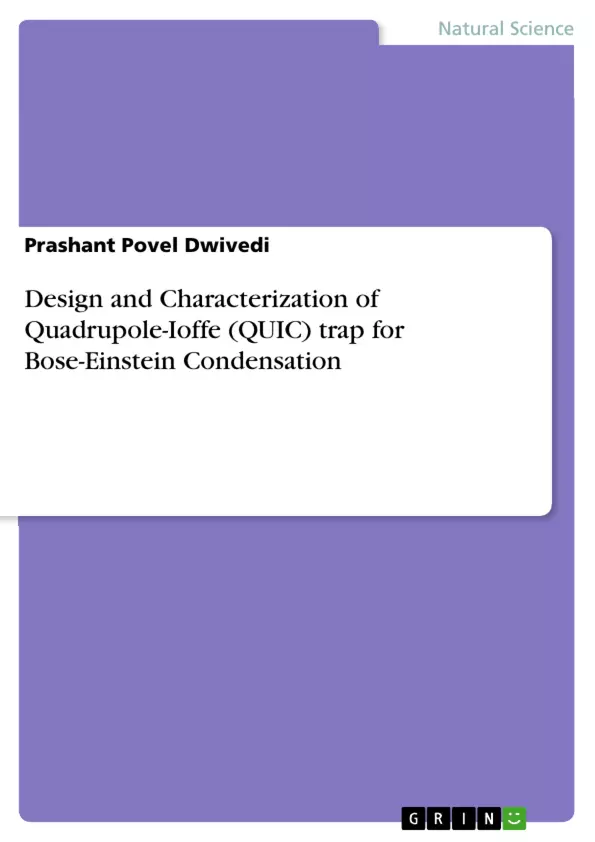Magnetic traps for neutral atoms play an important role in achieving Bose-Einstein condensation (BEC) of atomic gases. The simplest way to magnetically trap atoms is to use the quadrupole field created by two coils with currents in opposite directions. In this configuration the atoms with appropriate spin state can be trapped at the middle of the coil where field is zero. For an atom in a weak-field-seeking state, atom are trapped at minima of magnetic field. The potential in a quadrupole trap grows linearly with distance from the trap center, where the magnetic field is zero. The major shortcoming of quadrupole traps is that cold atoms are removed from the trap due to Majorana flips at the trap center.
This problem was overcome in time-averaged orbiting potential (TOP) traps and in Ioffe-Pritchard (IP) traps, which are both successfully used in current BEC experiments. However, the TOP trap is somewhat limited in its applications due to the low trap depth and the peculiarities arising from the rotating field. On the other hand, Ioffe traps require large currents and typically dissipate several kilowatts of power, which causes cooling, stabilization, and switching problems. Quadrupole Ioffe configuration (QUIC) trap consists of two identical quadrupole coils and one Ioffe coil, which is conical type, which operated at low currents and has no problem of spin flips at trap center because of finite field at the center. This trap dissipates less power, which simplifies the heat removal. If the current through the Ioffe coil is ramped from zero to its final value, the trapping potential smoothly changes from a quadrupole to an Ioffe potential. A current Iq through the quadrupole coils produces a spherical quadrupole trap in the center of the two coils. The trap is converted into the Ioffe configuration by turning on the current Iioffe through the Ioffe coil. With increasing current Iioffe the magnetic zero of the quadrupole is shifted towards the Ioffe coil. At certain value of Iioffe, the trap produce a non-vanishing offset field B0 and exhibit a harmonic variation of the potential close to the trap minimum. The advantage of the QUIC trap is that much lower currents are required and the coils can remain outside the vacuum. The disadvantage of this design is that the field minimum has moved toward the Ioffe Coil. This place a limit on optical access to the BEC QUIC trap generates a small finite magnetic field at the minimum of potential energy for BEC.
Inhaltsverzeichnis (Table of Contents)
- CHAPTER I. Introduction
- CHAPTER II. A Route to Achieve BEC in Dilute Gases
- CHAPTER III. Magnetic Trapping of Atoms
- 3.1 Optically - Plugged Quadrupole Trap
- 3.2 TOP Trap
- 3.3 Ioffe Trap
- 3.4 QUIC Trap
- CHAPTER IV. Calculation and Simulation of Magnetic
Field For QUIC Trap
- 4.1 Overview
- 4.2 Calculation of Magnetic Field due to Quadrupole Coils
- 4.3 Calculation of Magnetic Field of the Ioffe Coil
- 4.4 Magnetic Field Simulation Through Matlab
- CHAPTER V. Design of QUIC Trap
- 5.1 Design of QUIC Trap Coils
- 5.2 Design of QUIC Trap with Cooling Jacket
- CHAPTER VI. Observations and Results
- REFERENCES
- APPENDIX
- VITA
Zielsetzung und Themenschwerpunkte (Objectives and Key Themes)
This work focuses on the design and characterization of a Quadrupole-Ioffe Confined (QUIC) trap for achieving Bose-Einstein Condensation (BEC) in dilute gases. The objective is to develop a comprehensive understanding of the QUIC trap, its magnetic field properties, and its potential for trapping and cooling atoms to ultra-low temperatures.
- Magnetic Trapping of Atoms
- QUIC Trap Design and Characterization
- Magnetic Field Calculation and Simulation
- Achieving Bose-Einstein Condensation
- Applications of Ultra-Cold Atoms
Zusammenfassung der Kapitel (Chapter Summaries)
- CHAPTER I. Introduction: This chapter provides an overview of Bose-Einstein Condensation (BEC) and its significance in physics. It outlines the principles behind BEC and discusses the importance of magnetic trapping in achieving this state of matter.
- CHAPTER II. A Route to Achieve BEC in Dilute Gases: This chapter delves into the experimental techniques used to achieve BEC, highlighting the role of laser cooling and evaporative cooling in reducing the temperature of atoms to ultralow temperatures.
- CHAPTER III. Magnetic Trapping of Atoms: This chapter focuses on various magnetic trapping techniques used to confine atoms. It explains the principles of the Optically-Plugged Quadrupole Trap, the Time-Orbiting Potential (TOP) trap, the Ioffe trap, and the QUIC trap.
- CHAPTER IV. Calculation and Simulation of Magnetic Field For QUIC Trap: This chapter presents detailed calculations and simulations of the magnetic field generated by the QUIC trap. It examines the contributions of the quadrupole coils and the Ioffe coil, and demonstrates the use of MATLAB for magnetic field simulation.
- CHAPTER V. Design of QUIC Trap: This chapter focuses on the practical design aspects of the QUIC trap, outlining the design of the trap coils and the inclusion of a cooling jacket for temperature control.
Schlüsselwörter (Keywords)
This work focuses on the concepts of Bose-Einstein Condensation (BEC), magnetic trapping, QUIC trap, magnetic field simulation, and the design and characterization of ultra-cold atom experiments. It explores techniques like laser cooling and evaporative cooling, and utilizes software such as MATLAB for simulations. These keywords encapsulate the core themes and techniques employed in this research.
- Citation du texte
- Prashant Povel Dwivedi (Auteur), 2020, Design and Characterization of Quadrupole-Ioffe (QUIC) trap for Bose-Einstein Condensation, Munich, GRIN Verlag, https://www.grin.com/document/932833



